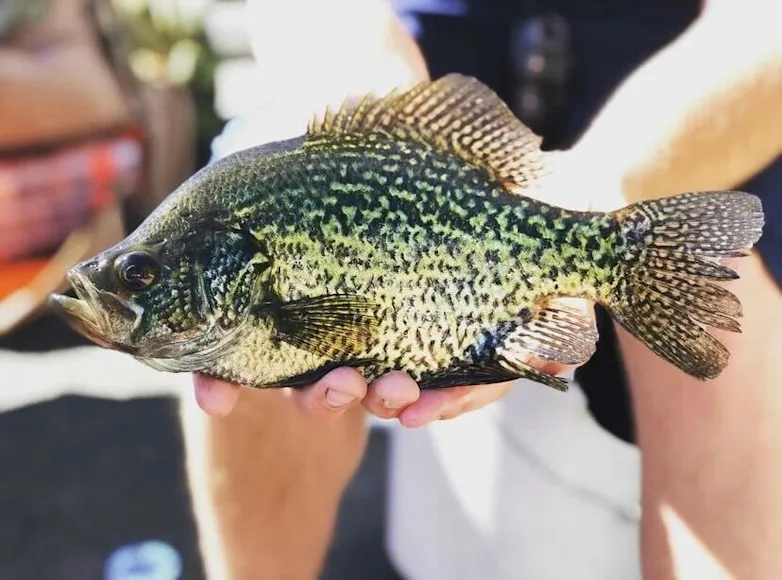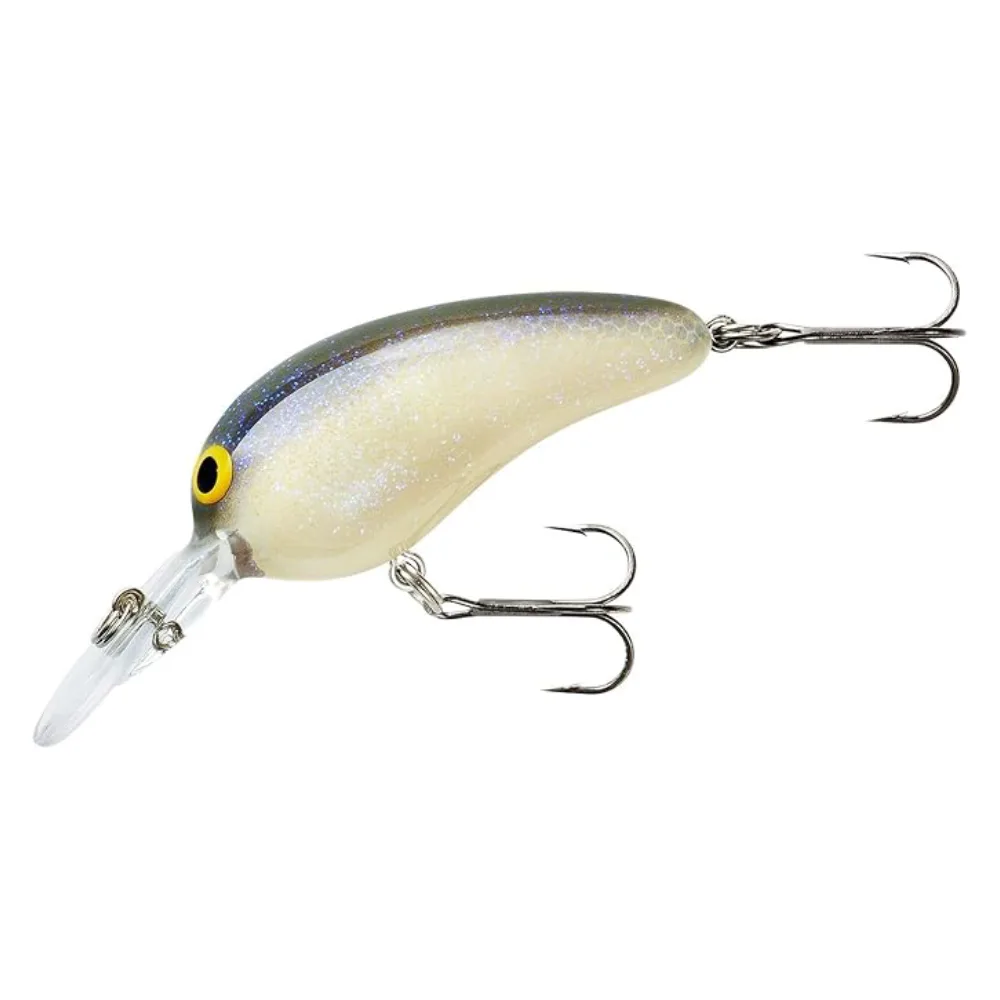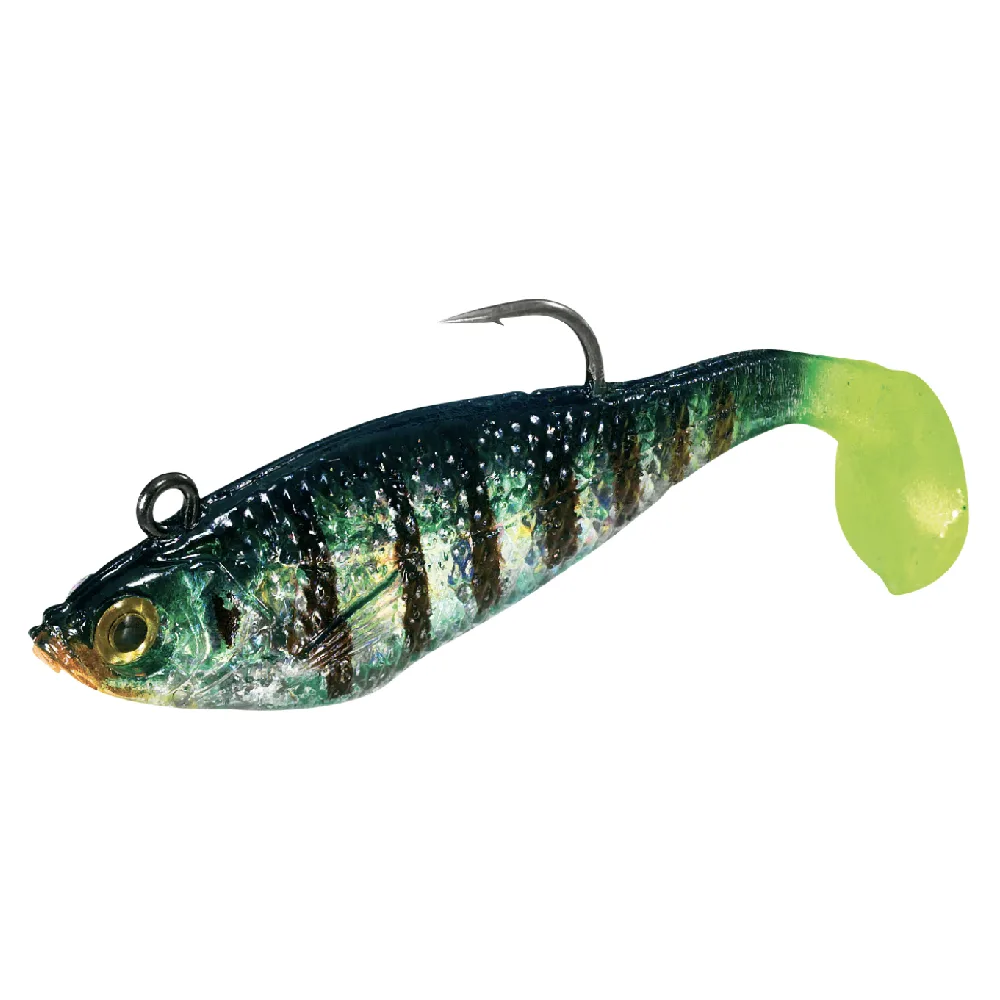We may earn revenue from the products available on this page and participate in affiliate programs. Learn more ›
Today’s crappie lures come in a vast array of sizes, colors, patterns and actions. And that’s a good thing, because you never know where you’ll find these nomadic fish and what will trip their trigger on the days that you get to chase them. Often, for no apparent reason, they want a lure of a specific size or shape that wobbles or wiggles in a certain way.
Live bait, such as a minnow hung under a float, which is one of our top reviewed crappie bait rigs, may seem like a simple solution to the complex crappie-catching puzzle. But an artificial lure, which doesn’t have to be kept alive or require regular re-rigging, is often a more efficient and effective choice. Unfortunately, all fishing lures aren’t created equal. Some deliver more than others, distinguishing them as the best crappie lures on the market.
Best Overall: Bass Pro Shops Crappie Maxx Squirmin’ Squirt
Best Spinner: Northland Tackle Thumper Crappie King Spinning Jig
Best for Shallow Water: Norman Lures Deep Baby N Crankbait
Best Pre-Rigged: Storm WildEye Swim Shad

Best Overall: Bass Pro Shops Crappie Maxx Squirmin’ Squirt
Specs
Weight: Internal jig heads up to 1/8 ounce
Patterns: More than 70 colors
Profile: 1.5-inch slender body with lively tentacles
Pros
Myriad color combinations make matching forage and conditions easy
Poured from a plastic that’s soft and durable
Can be presented by casting, trolling or shooting under docks
Cons
Small body limits internal weight choices
Tube jigs are a staple of crappie fishing. You only need to look at the many choices available to know that’s true. The Maxx Squirmin’ Squirt does everything those do and much more, starting with its salt-impregnated plastic. While it may attract crappie, it does more to encourage them to hold onto your tube longer. That creates time to set the hook, which is handy if some wind-driven slack in your line keeps you from immediately detecting a bite.
While Maxx Squirmin’ Squirts are offered in a 2-inch size, the compact 1.5-inch version is more attractive to more crappie in more situations. It’s an easy meal for active crappie, for example, and an appropriate one for those numbed by a cold front. Available in more than 70 colors and patterns, you’ll always have access to the hot color, no matter when or where you plan to fish.
Like all hollow tube baits, this one dips and dives best when rigged on an internal lead head jig. But its small diameter makes it difficult to insert a jig weighing 1/8 ounce or more, which may be needed on windy days or in deep water. In those situations, rig it externally on a traditional ball or darter head, though either will slightly dull its action.
Best Spinner: Northland Tackle Thumper Crappie King Spinning Jig
Specs
Weights: 1/32 and 1/16 ounce
Patterns: Eight color combinations
Profile: Lifelike minnow-shaped head and slim curl-tail grub
Pros
Blade and tail create plenty of action
Lifelike head and body entice crappie to eat
Its hook is larger and stouter than similar lures
Cons
Relatively heavy weights make it a poor choice for trolling
Limited color selection is difficult to fine tune to conditions
No list of the best crappie lures is complete without a jig that sports a spinning blade. Northland’s Thumper Crappie King fills that spot here. The lure mimics a well-known baitfish, thanks to a minnow-shaped head that appeals to clear-water crappie. Its wire keeper holds soft-plastic trailers more securely than a molded one. While available in a select few colors, its curl-tail grub is easy enough to switch out, whether to your favorite pattern or the one crappie are biting best on a particular day.
This jig’s main attraction is its blade. Positioned near the rear of its head, it features a hammered finish and is slightly larger than what’s used on similar crappie jigs. That means more flash and a more pronounced thump. While the lure is productive in clear water, it’s deadly in stained and muddy water—something crappie anglers encounter far too often in spring.
The Thumper Crappie King’s red hook is all business. The 1/32 model has a No. 4 hook and the 1/16 version a No. 2, both stout selections for such a compact offering. Those combinations are perfect for casting to aquatic vegetation, sunken brush and docks. But their relatively heavy weight makes them tough to use on a trolling rig, forcing a faster-than-usual pace to avoid snagging on bottom.
Best for Shallow Water: Norman Lures Deep Baby N Crankbait
Specs
Weight: 1/8 ounce
Patterns: Six color combinations
Profile: 1.5-inch rounded body
Pros
Fishes quickly, allowing you to cover plenty of water
Action draws reaction strikes, even from inactive crappie
Casts or trolls equally well
Cons
Diving depth is limited
Jigs and soft-plastic lures take up most of the space in a tackle box for crappie fishing. But make room for crankbaits, especially Norman Lures Crappie Crankbait. The smallest member of the legendary tackle-makers N series, its medium-tight action and rattles are a one-two punch that crappie can’t dodge.
This floater-diver, which also goes by the name Deep Tiny N, can be trolled along creek channels or cast at targets in shallow water, which forces fish to spread out rather than stack up. It also works well for schools of crappie suspended over deep water. And once it grabs their attention, its super-sharp No. 10 trebles ensure they end up in your boat.
Even with a spinning rod and sewing-thread-thin 6-pound test monofilament crappie fishing line, this crankbait’s diving depth bottoms out at 6 feet. You may get a few inches more by using fluorocarbon line, which, unlike monofilament, sinks. If that’s not enough to catch the crappie you are targeting, a few snippets of lead tape can be added to its belly to get some more depth or casting distance on a windy day. But be careful about how many. It only takes a bit too much to kick your crankbait out of kilter.
Best Pre-Rigged: Storm WildEye Swim Shad
Specs
Weight: 1/8 ounce
Patterns: 12 color combinations
Profile: 2-inch minnow-shaped body with swimming tail
Pros
Pre-rigging ensures a proper and consistent action
Lifelike profile and patterns catch wary crappie
Cons
Only available in one weight
Activating tail requires a relatively faster retrieve or troll
Swimbaits have proven their effectiveness time and again. They’re a mainstay in bass fishing, and ones as long as your forearm are gaining traction in musky fishing. It’s no different in crappie fishing, where Storm’s WildEye Swim Shad leads the way. Its lifelike profile and swimming action is the perfect combination for covering water and catching crappie.
WildEyes are pre-rigged at the factory, where bodies are molded around lead heads. That’s a huge relief, because threading a traditional swimbait perfectly straight on a jig head is a chore that becomes bigger as swimbaits get smaller. Any kink can kill its action and induce line-twisting spirals.
This swimbait can be worked vertically like a jig or horizontally like a crankbait, though its depth depends on how long you let it sink. Swimbaits with tails that are perpendicular to their body make the most action. It’s easy for them to grab water, even at the slowest retrieve speed. But the WildEye’s tail is raked back to about 45 degrees, so it needs slightly more forward speed to kick. Make sure you move it fast enough.
How We Picked the Best Crappie Lures
There’s no question that the same types of lures will catch crappie, regardless if they’re swimming in a dingy Carolina reservoir or slow-flowing Upstate New York river. Tubes, jigs, and crankbaits are among those lure types, and I have tackle boxes filled with them to prove it. But within each category, certain lures work better than others—and their effectiveness all comes down to the details. So, when looking for which ones are best, consider these characteristics.
Weight
Are there options for different depths? Lightweight lures rule crappie fishing. While the most popular crappie lures weigh between 1/32 and 3/32 ounce, there are times when others come into play. Ice fishing lures, for example, can weigh 1/64 ounce or less. And on windy days, or when fishing extreme depths, you may need a 1/8- or ¼-ounce lure to be able to cast or feel your lure. So, the more weight choices for a lure, the more versatile it becomes.
Profile
Does the lure look like a baitfish? Crappie prefer minnows, so your lure should resemble one. It should be relatively long and slender. The best all-around length is 1.5 inches, but there are exceptions. If the water is muddy or cover heavy, a slightly longer lure will create a bigger target that displaces more water. That makes it easier for crappie to find and eat.
Patterns
Is the crappie lure offered in a wide selection of colors? Crappie are choosey, and often prefer a particular color or combination of colors one hour or day, then something totally different the next. So it’s important that a lure is available in several patterns, allowing you to fine tune your presentation to current fishing conditions.
Efficiency
Will you spend more time fishing or fixing it? Durability is an especially important trait for soft-plastics. Tough ones stand up to multiple catches, but soft ones create more action. The best ones are made from plastics that fall somewhere in between. Durability also extends to rigging. Your lure needs to stay on the jig head, so you aren’t fixing it, or reaching for a new one, after every cast.
What To Look for in a Crappie Lure
Many variables go into crappie fishing. Location and depth must be considered alongside cover and structure options. But the biggest, and the one you have the most control over, is presentations. There are plenty of crappie lures on the market. And while all constitute small packages, the best crappie lures pack in a lot. Identifying those requires comparing the following characteristics.
Size
The most popular crappie lures weigh between 1/32 and 3/32 ounce, though there are times you may need one that’s lighter, such as when ice fishing, or heavier in deep water or windy conditions. So, it’s important that a lure be offered in several weights or have the ability to easily change weights.
Color
Color, whether one or several in combination, is an important trigger for catching crappie. While I’ve found a pink-bodied tube with pearl tails a good choice in many situations, there are days when it won’t draw a strike. So, you need options—the more the better. Some days natural baitfish patterns will work best, especially when the water is clear and sun bright. But if you find yourself fishing on a dark overcast day or in muddy water, you’ll need something gaudier. Fire Tiger, for example, doesn’t match anything crappie eat. But its combination of neon green, chartreuse, orange, and black stands out, making it easy for them to find.
Shape
Crappie, regardless of where they swim, mostly feed on minnows. So, you’ll want a lure that resembles one. It should be compact. Most crappie lures are between 1.5- and 2-inches long, but they can measure up to 3 inches. Details matter, too. Sculpted heads, realistic tails and even the addition of fins can make a difference in how many crappie you catch.
Action
Besides looking like minnows, lures should move like them. That includes swimming, darting and hovering actions. Those can be created in several ways. Swimbaits, for example, have a tail that kicks when retrieved, and a crankbait’s bill causes it to dive and wobble. Lightweight crappie jigs sink so slowly that they appear to hover, especially when moved by a drifting or trolling boat.
FAQs
Q: Does water depth play a role in using crappie lures?
Water depth plays an important role in using crappie lures. Over the course of a year, crappie can be found in a variety of depths, from cruising shallow water in spring to clinging to brush piles in deep water in summer. So, you’ll need lures of different weights to catch them at different depths. At their essence, lures are tools—designed to do a specific job. Lures built with more weight, for example, perform better than lightweight ones in deep water, because they sink faster, and it’s easier to feel them with your rod.
Q: Do I need to use a bobber for crappies?
You don’t need to use a bobber for crappies, but one will help in certain situations. Suspending a live minnow under one, for example, is a well-used approach to crappie fishing. Suspending a small jig under one can be just as productive; waves move the bobber, imparting an action on the jig below, attracting crappies. With either presentation, a slip float is key. Your line travels through its center until a bobber stop, usually a small knot or bead attached to your line, reaches it. The stop is adjustable, allowing your lure or bait to sink to almost any predetermined depth. That reduces the length of line below your bobber, making casting easy. It’s a perfect presentation for reaching suspended crappies.
Q: When is the best season for crappies?
Spring is the best season for crappies. Warming water temperatures draw them to shallow water, where they feed aggressively and spawn. That makes them easy to find and catch. Search around docks, submerged brush piles, emergent vegetation and laydowns. Rarely will you fish deeper than 10 feet. Don’t stop fishing for them when the calendar turns. Crappie can be caught year-round, though more effort is often required. While winter angling, especially through the ice, ranks a close second to spring, summer and fall are the most challenging seasons. It’s then that crappies wander through open water, chasing baitfish schools that change location and direction with the wind.
Q: Can I use crappie jigs for other fish?
You can use crappie jigs to catch other fish. In fact, that’ll happen often while you’re targeting crappie. Panfish, from rock bass to bluegills and yellow perch, won’t hesitate to eat one. That goes for white perch and white bass, too. And they’re a good choice for springtime largemouth, smallmouth in small rivers and walleye made spooky by shallow water. While you can’t count on these jigs to produce quality bass or walleyes, they more than make up for it with quantity. And who doesn’t want to catch more fish?
Final Thoughts
Consistently catching crappie requires presenting lures that feature particular actions, profiles, and patterns in a variety of conditions and situations. But not every lure offers those traits. The ones that do are considered the best—and they might even help you catch a record crappie.
Why Trust Us
For more than 125 years, Field & Stream has been providing readers with honest and authentic coverage of outdoor gear. Our writers and editors eat, sleep, and breathe the outdoors, and that passion comes through in our product reviews. You can count on F&S to keep you up to date on the best new gear. And when we write about a product—whether it’s a bass lure or a backpack—we cover the good and the bad, so you know exactly what to expect before you decide to make a purchase.





